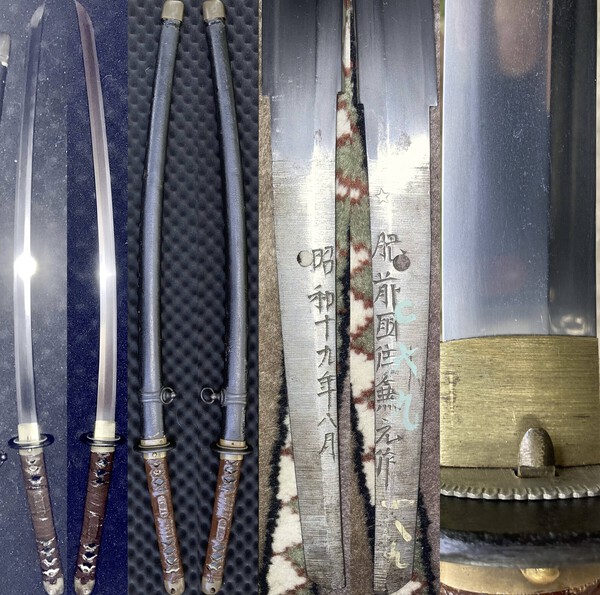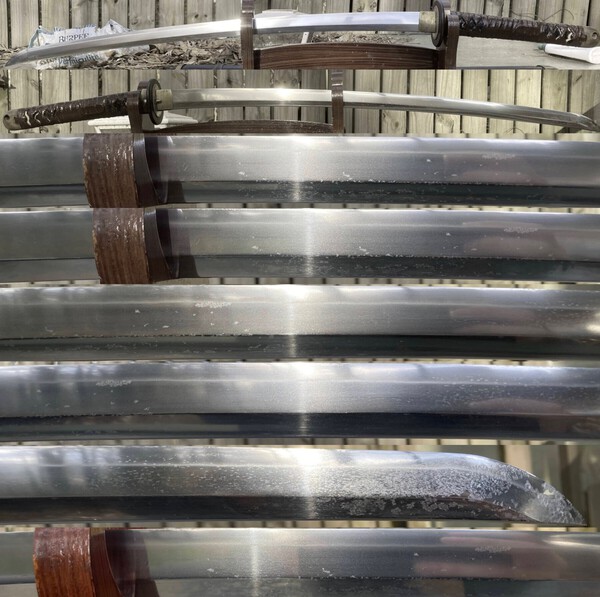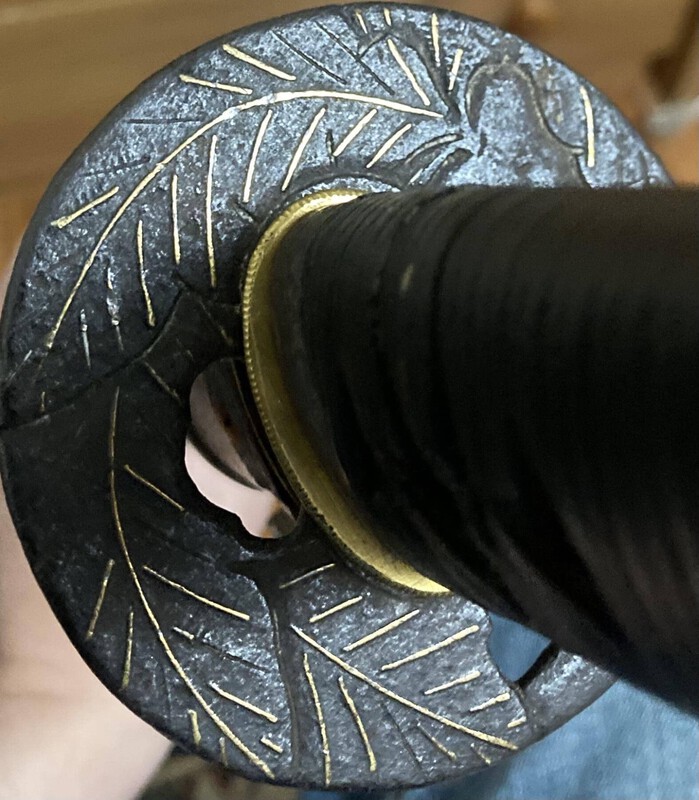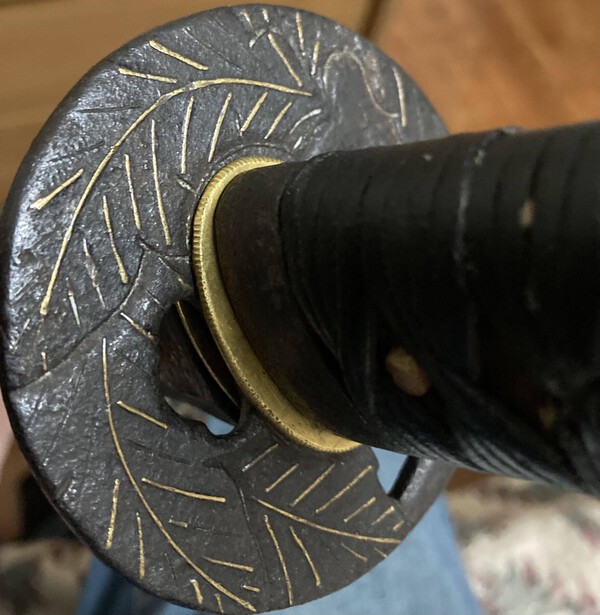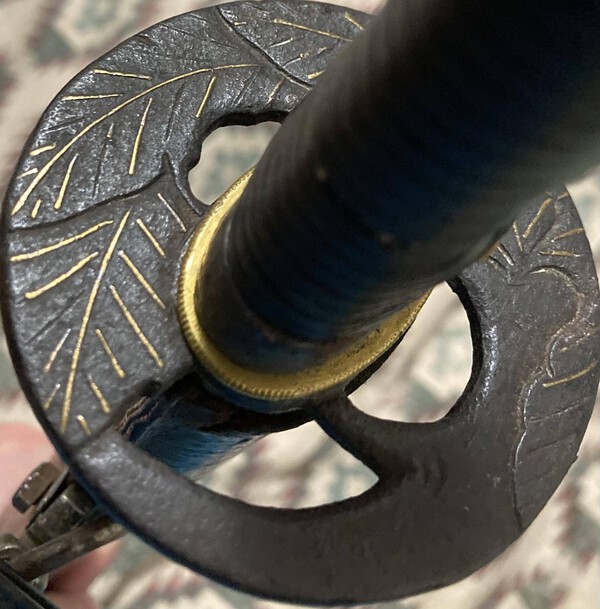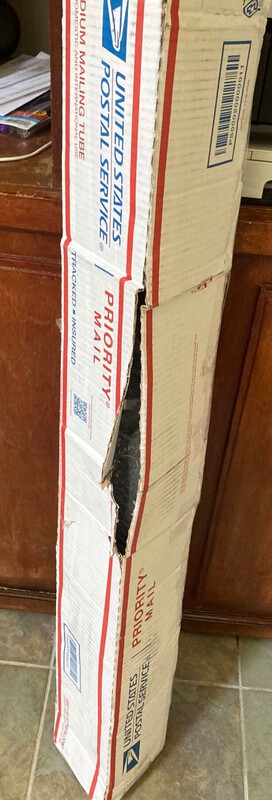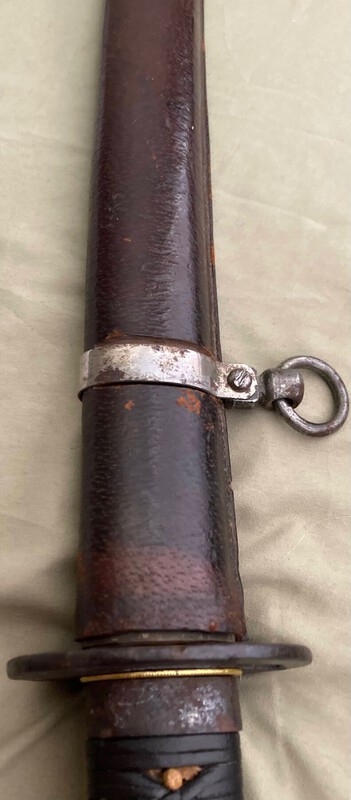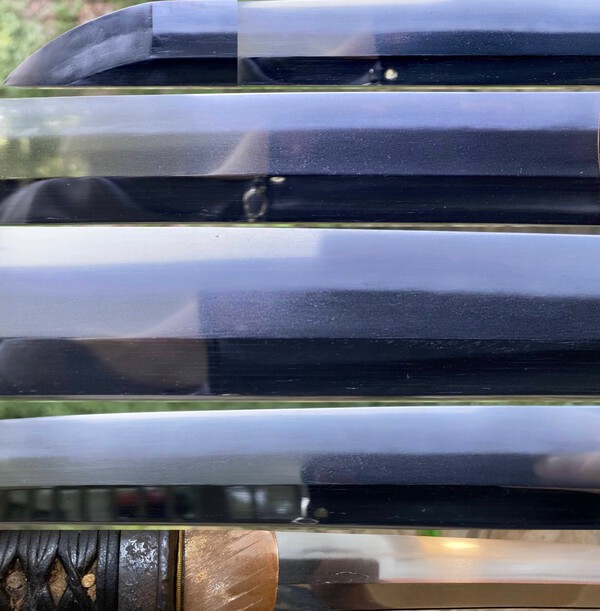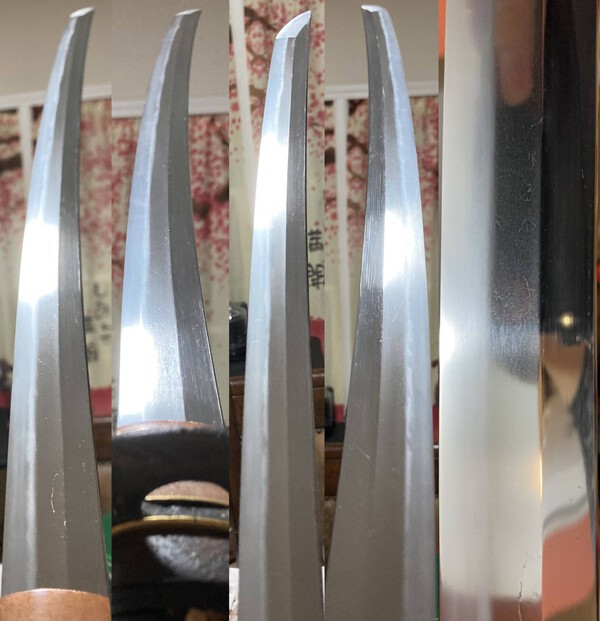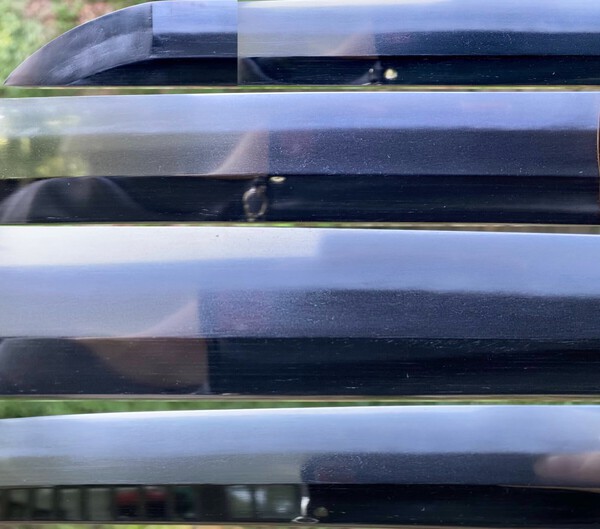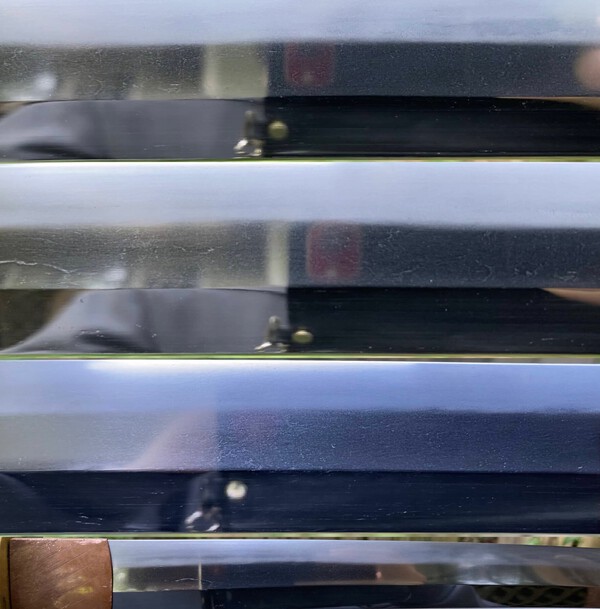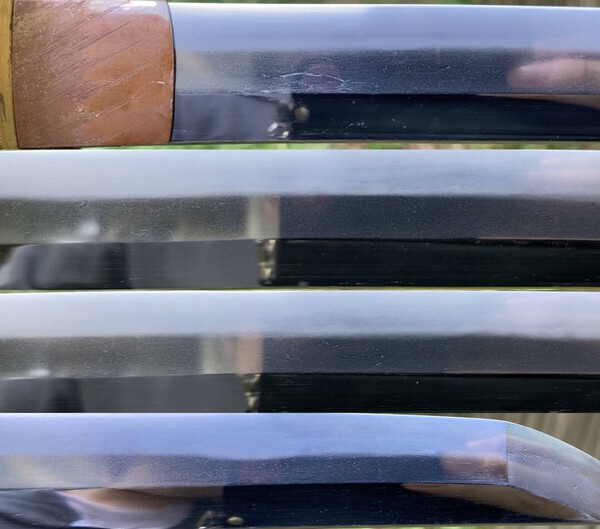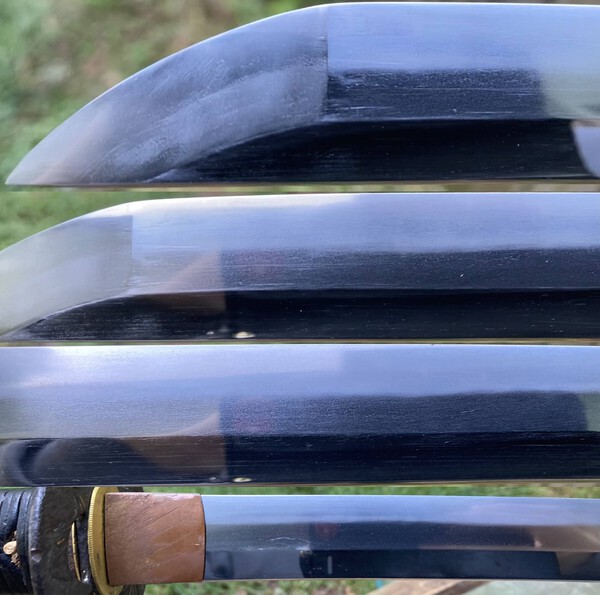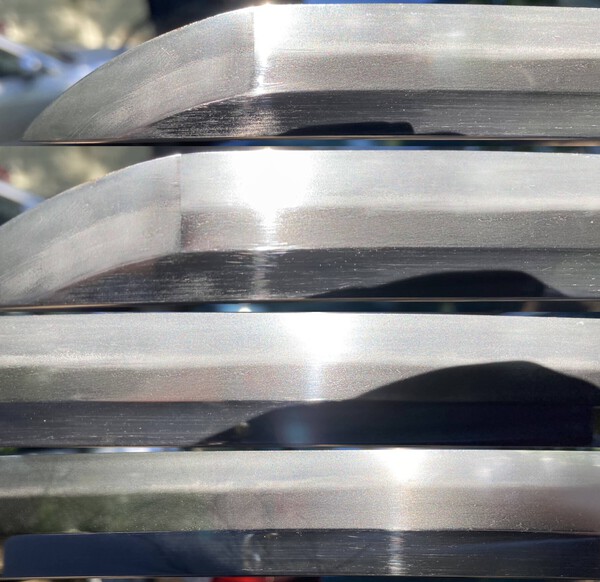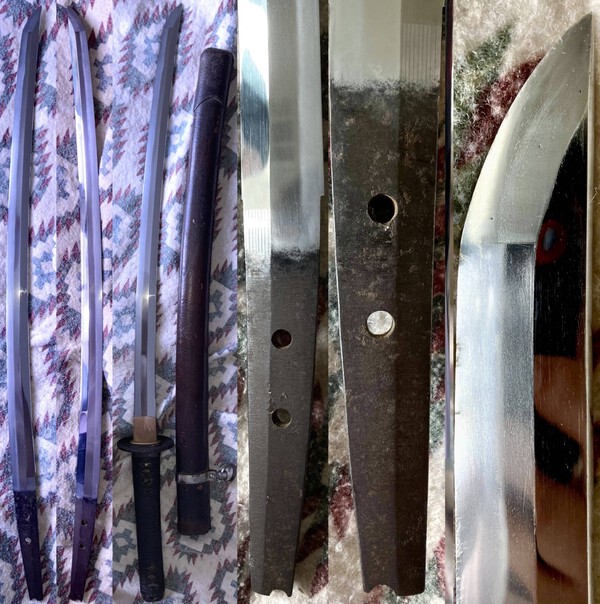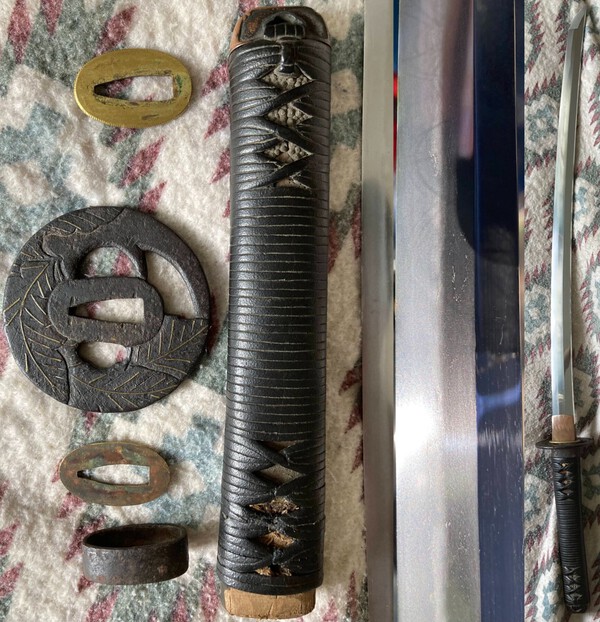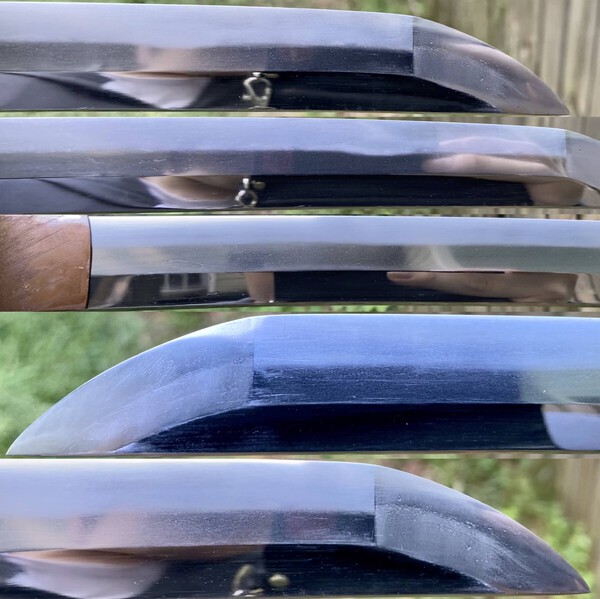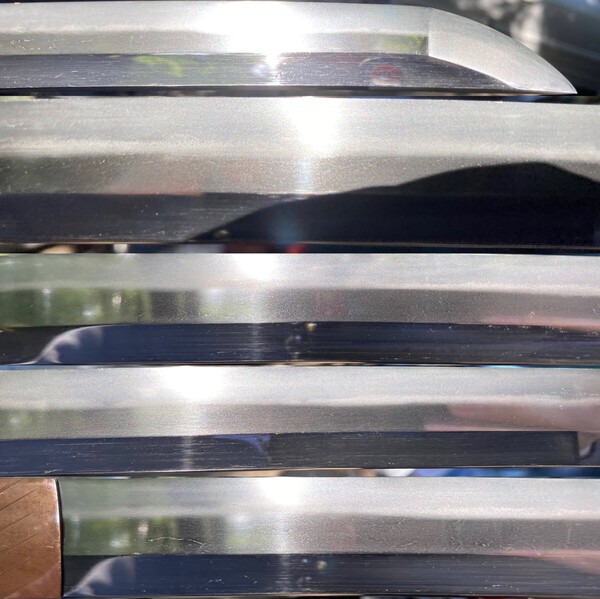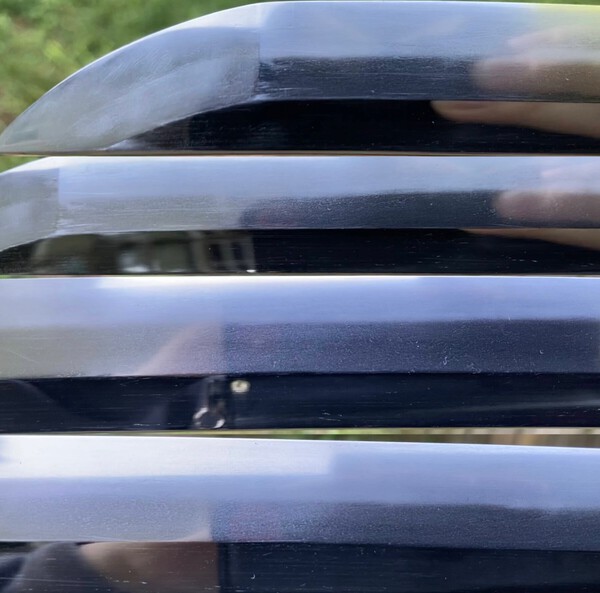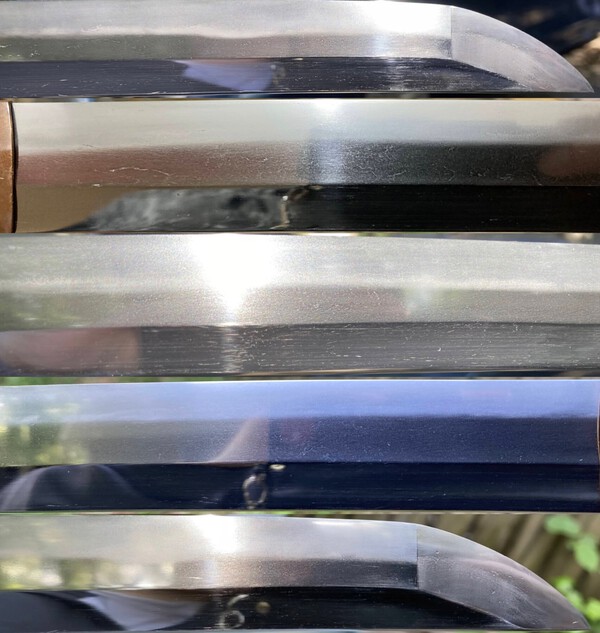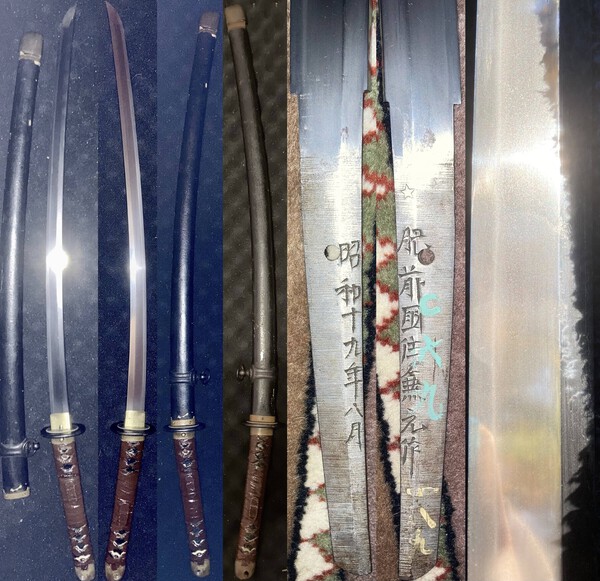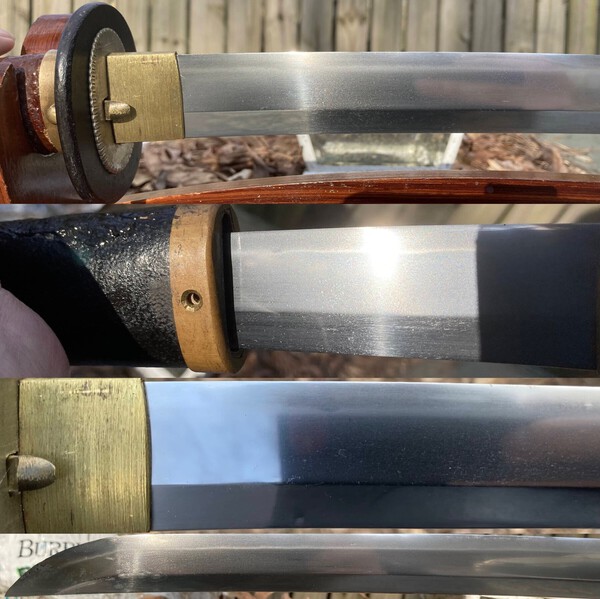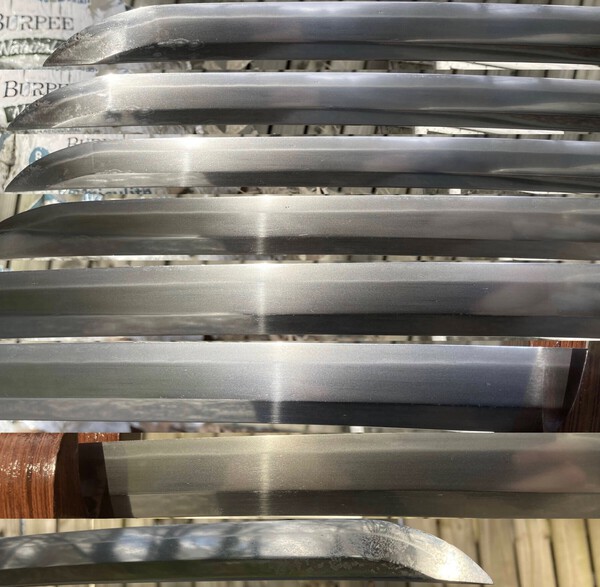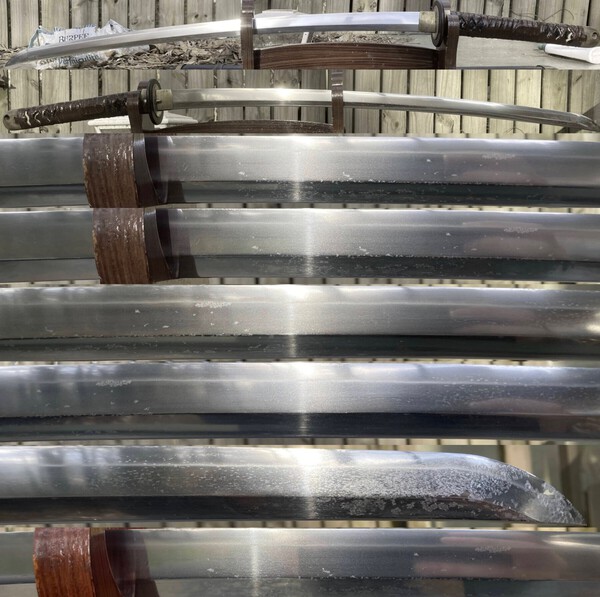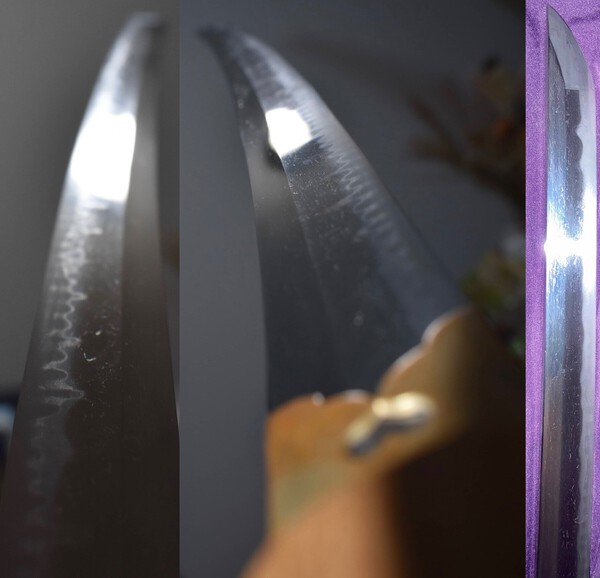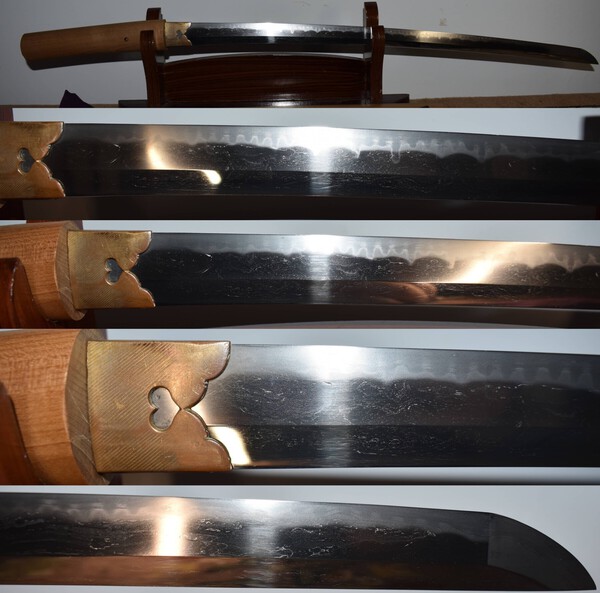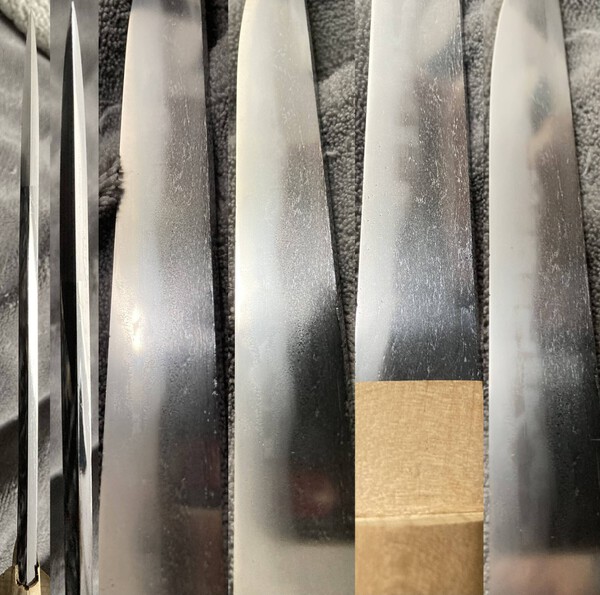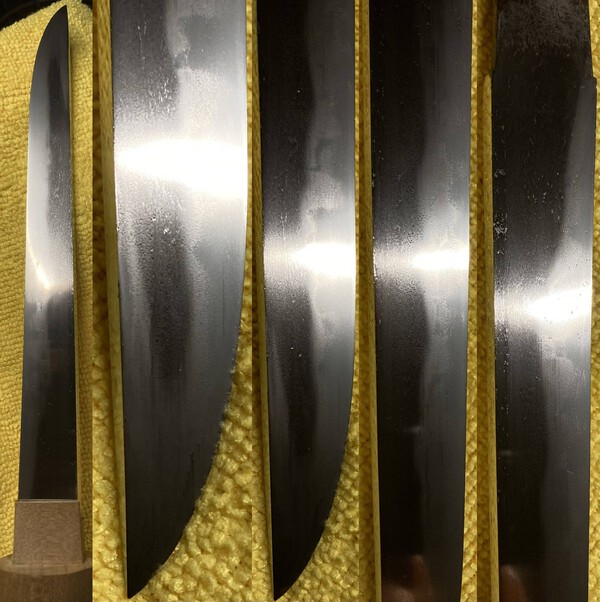-
Posts
253 -
Joined
-
Last visited
-
Days Won
1
Content Type
Profiles
Forums
Events
Store
Downloads
Gallery
Everything posted by AntiquarianCat
-
I know I’m sure to strike out but something makes me want to say Bizen Kiyomitsu.
-
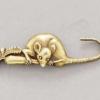
An interesting short gunto with an osuriage ancestral blade
AntiquarianCat replied to AntiquarianCat's topic in Nihonto
I thought the Hizen hypothesis interesting so I took photos of my Hizen gunto under the same lighting conditions and honestly they look similar. Of course the mystery sword has some spots where the hada and hamon aren’t as tight but that could be because of centuries apart in make and more polishes. They both have a lot of komokume and nie and konie hamon. Also both are robust with little taper and broad kasane. In fact the wakizashi I’m curious about has a broad kasane with almost no narrowing at the kisaki. I’ve read about that robustness being a Hizen trait so it would be interesting if this new sword -also a survivor of the war- turns out to be from Hizen too. -

An interesting short gunto with an osuriage ancestral blade
AntiquarianCat replied to AntiquarianCat's topic in Nihonto
Yes, it pretty much looks like the leather covered saya my gunto with a kanbun blade had. I’ll admit I don’t know the proper name for this but Fuller book mentions civilian swords converted for use by adding leather and the iron ashi and this sounds like them. -

An interesting short gunto with an osuriage ancestral blade
AntiquarianCat replied to AntiquarianCat's topic in Nihonto
I *think* that the tsuka only has one hole, that marking and depression an inch below the currently used hole looks to me more a result of damage than a patched hole. I did wonder if it could be Hizen so I’m glad to see someone else got that impression. Sukesada is a very interesting suggestion as well, for some reason this sword’s hada, hamon, and jigane hue did remind me a bit of my muromachi Bizen. Thanks everyone -

An interesting short gunto with an osuriage ancestral blade
AntiquarianCat replied to AntiquarianCat's topic in Nihonto
Also, I examined the tsuba under lighting. It looks like typical wrought iron with that odd luster it has when struck by light, old brass inlays that half half fallen out. Nothing remarkable but certainly not standard type 98. The fuchi also had inlay work but it’s so eroded I can’t make out anything. As shown the same has worn off everywhere except the lower tsuka. Also, I dodged a bullet while receiving this sword: the container came open, cut with a knife or something and the contents showing. It was already like that when the mailman dropped it off so I suspect someone in the distribution post office cut it to see if it would be worth snatching and thankfully got cold feet. -

Real or fabrication
AntiquarianCat replied to drb 1643's topic in Auctions and Online Sales or Sellers
I wish this seller didn't amateur polish his swords. Many of them would've been perfectly fine blades if he just left them in old polish. It’s akin to the guys that clean old silver coins with steel wool. -

An interesting short gunto with an osuriage ancestral blade
AntiquarianCat replied to AntiquarianCat's topic in Nihonto
Here are a few more photos in case they help. It might be worth adding that the jigane has something of a bluish hue (compared to some of my other swords) when in daylight temperature light. I do plan on taking this to the shinsa (if I can make the show) but I guess for now I’d like to estimate as much as I can about this sword. -

An interesting short gunto with an osuriage ancestral blade
AntiquarianCat posted a topic in Nihonto
Hello again everyone, I guess I’ve been on a gunto detour as of late and grabbed what I was told was a tank/pilot’s gunto with an old blade in it. I’d value everyone else’s thoughts on it. It looks too me like one of the civilian mounts converted to gunto use that Gregory and Fuller talked about in their book I think Higo koshirae instead of standard type 98 fittings. The blade is an osuriage o-wakizashi with a nagasa of 56.2cm, so a cut down katana. I’m told it’s probably Kan´ei or kanbun shinto. That makes sense but a few things make me think otherwise: the blade has relatively little taper with a motohaba of just under 3.2cm and sakihaba of about 2.4cm, it also has a larger than average kissaki for kanbun and wide kasane. I guess that could be Kan´ei, but I’m under the impression that if it weren’t osuriage much of its sori would be saki sori so I wonder if it couldn’t be a Muromachi piece? It's in old polish. The konie hamon is suguha with some dips in the temper line and ashi. The hada has some nie and seems to be mostly ko-mokume and ko-itame, shinogi also seems to be mokume/itame. Boshi has a good amount of nie and looks like hakikake. The hada and hamon remind me a bit of my Hizen blade but I think the mokume on this one isn’t small enough to be hizen. Could I be looking at a blade from one of Kyushu’s traditions like Bungo Takada? I feel like it looks a bit like some of their swords. Thanks everyone -
I hope you’ll forgive the late reply as an annoying illness and real life kept me busy but your nice hizento inspired me to take a few photos of mine. To me they look quite similar and I would find it very cool if yours was a custom order counterpart to the RJT one I own. That would certainly explain why the fittings yours have look so splendid. I’m a fan of your habaki(and mon, and pretty much everything). I’ve always read about how many RJT smiths still did custom work during the war so it would be really interesting to compare that to their RJT swords.
-
I guess a better way to put my question is if it is still proper to call it a katana? I think the trend seems to hold up with NBTHK papers: this one at 60.6cm got katana, while this one 60.0cm did not. I understand two swords shortened to 60.8 or 60.4 are basically the same thing, so it's a dumb game I'm playing, but I am interested about the proper terminology with borderline cases like this.
-
Thanks again for all the help everyone, I've got only one more question: I dug up the torokusho and export paperwork and it turns out the nagasa is in fact... 60.6cm: right at the boundary. Both the torokusho and export papers explicitly classify it as a Katana (刀) and all wakizashi I've imported always got わきざし or 脇差; also, even this huge 59.6cm wakizashi still gets classified a wakizashi in torokusho and other papers. Would it be right to assume then that by Japanese standards this is supposed to be a long sword? Thanks again
-
Would you think signing with a made up title might be akin to how much of the French nobility who didn’t hold titles would just up and award themselves their own courtesy titles? So long as they didn’t steal protected titles the crown turned a blind eye to it.
-
Wow, the plot certainly has thickened. Thank you so much for the excellent discussion everyone, it's certainly a lot of food for thought. That this might not have been a katateuchi, people possibly awarding themselves odd titles reminding me of how the second estate in the ancien regime made up most of their titles and got away with it so long as they didn't steal protected ones... and the Inome. Thank you for enlightening me about Inome, it's very interesting to know that what the occident might see as harmless funny heart was actually a fierce and bestial symbol to the samurai. I guess that shows symbols are not always universal.
-
Interesting, do you think the lower mekugi ana is the original? Or would more shortening than I thought be possible? Thanks a lot for the link. Assuming it lost a couple of inches it looks like it would have been on the longer end of that range.
-
60.7cm, the export papers (which I left in a separate residence and can’t access) put it as a katana but my understanding is a couple mm shorter and it would be a wakizashi.
-
Hello again everyone, I know this blade is no treasure - it being a cheap sengoku study piece I grabbed a couple years ago - but the habaki made it pretty fitting for this occasion, so I hope you will forgive it. Also, I'd like to see if my Kantei skills are getting better so here goes: sugata is stereotypic late Muromachi, short (barely at 2 shaku) not very tapered and saki-sori so its a katateuchi; itame with some masame (mostly in shinogi) and heavy amounts of ji-nie, and what looks like a nie togari-gunome hamon. That makes me think I'm looking at a sue-seki or some other sengoku mino blade, Kazu-Uchi mono probably. Would this be a correct assumption? Also it seems to be signed by some "kanesada" but the signature doesn't match any examples so I got it under the presumption it was gimei. Would that be correct? Thanks again everyone
-
Funny, out of boredom I once linked him to http://www.japaneseswordindex.com/unji.htm I told him his “reverse edge sword” was really a gardening knife and offered him 400$, a fair price. I got crickets for my reply. Probably for the better since that’s still pricy and he’s known to tamper with swords and acid dip them.
-

Source for Quality Uchiko Ball + Powder
AntiquarianCat replied to tbonesullivan's topic in General Nihonto Related Discussion
The only Uchiko I would trust was would be the one personally made by Robert Benson. You can find it http://bushidojapaneseswords.com/store/p363/Small__Polishers_Uchiko_Ball__.html Unfortunately it’s out of stock and I wouldn’t trust anything else that would risk being coarser. -
True, I should remember just because a word is similar doesn't mean it's appropriate. If it is older than Edo that would be very interesting for sure. The kasane did certainly seem quite thick for a blade its size. Is it possible to make a rough guess as to the jidai and what tradition might have influenced it? Thank you again for your help, I always wind up learning something each time come here.
-
Hope this one is not too big but I've got a little dagger I'm fond of, I think it was a kaiken. It's mumei and I don't know much about it but I'm guessing the flamboyant hamon and masame at the bottom and mokume-itame elsewhere means it's probably from the Edo period.
-
I don’t know who that ebayer is but I wouldn’t be surprised if he bought a busted Showa22 sword and now has the nerve to try and flip it for even more. Buffing marks, misshapen geometry, acid stains, even the busted kissaki all remind me of the nearly worthless wrecks he sells.
-
One thing that still impresses me about amateur polish is its ability to make its nihonto victims resemble shoddy counterfeits. As all the people better informed than me said; amateur polishes are bad as it will cost a fortune to pay a real polisher for the chance to salvage the blade and till then, your sword has next to no resale value. That’s part of what makes eBay so risky as many big sellers like Showa amateur polish their swords and conceal that with low resolution zoomed out photos. So you could buy what you think is a fine sword with bad photos and find out he or any other seller gave you a sword damaged beyond repair. Also it sort of looks like the sword you posted has the same kind of buffing and acid marks Showa22 blades do. It also has a not straight shinog-ji so it’s in a pretty bad way. It worries me that sellers are doing this rather than letting swords stay in old polish.
-
Hello Glenn, I also agree with the late muromachi attribution: it looks like your sword has a lot of sakisori and a fairly wide mihaba. If it helps, Markus Sesko has an excellent site for recognizing date by sugata https://markussesko.com/2015/04/03/kantei-1-sugata-6/
-

Polisher recommendations
AntiquarianCat replied to Edward Mahle's topic in General Nihonto Related Discussion
My apologies, I should admit I am unsure if Mr. Benson completed a full course of study but regardless I have been told by American collectors far more learned than me that he’s very well regarded and fully qualified to polish swords. Equally important is that I have found him to be friendly and willing to take time to answer questions from a relative neophyte like me, even if he is busy. I think his willingness to help and answer questions about which blades are worth or need a polish, and which don’t is very helpful to newer people like me.










